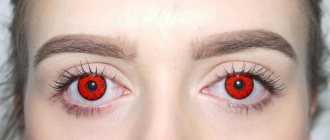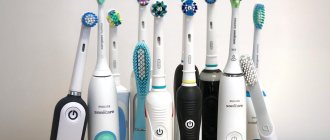HomeArticlesArticles about lensesContact lenses: what are they? Which lenses to choose: colored or tint
Published:
Back to archive
Colored and tinted contact lenses are cosmetic lenses because they are intended primarily to change one's appearance. Colored lenses radically change the color of the eyes, while tinted lenses emphasize the natural color or slightly change the shade of the light iris of the eye. This is the difference between colored and tinted contact lenses.
Tinted and colored contact lenses come with and without diopters, so they can be used by both patients for simultaneous vision correction and people with normal vision to change eye color.
What are decorative contact lenses
In addition to colored and tinted ones, there are also decorative contact lenses: carnival, club, theater. These are lenses of bright unnatural colors, with unusual designs and pictures. Such lenses imitate images of vampires, aliens and other “monsters”. Decorative lenses are great for costume parties and Halloween, but they should not be used for everyday life and everyday wear.
When to choose colored lenses and when to choose tinted ones
The difference between colored and tinted contact lenses is the color intensity. Tinted lenses are suitable for owners of light eyes; with their help, you can emphasize and make your natural light eye color more expressive or even slightly change it. But you won’t be able to change the color of dark eyes using tinted contact lenses.
You can radically change the color of dark eyes, much less make them light, only with the help of colored contact lenses. Thanks to their dense and rich pattern, colored lenses can cover the natural color of the iris and create a new image.
Thus, both tinted and colored lenses are suitable for light eyes, but for dark eyes it is better to buy colored contact lenses.
Do colored lenses harm your vision and eyes?
High-quality products use natural and harmless dyes. They are located on the inner surface and do not come into contact with the cornea. Proper operation and compliance with all rules for their use and storage guarantee safety for eye health.
But any glass, even the thinnest one, is a foreign body on the surface of the eye. Periodically, the eyes need to be given a rest, taking them off, for example, at night, so that the eyes are saturated with oxygen and do not stop the self-cleaning process.
Features of colored contact lenses
Colored and tinted lenses are just as comfortable to wear as regular lenses for vision correction. You can see clearly in them, they are soft and elastic. However, if the pupil is dilated, the lens pattern may slightly obscure the view, and the person may experience visual discomfort. For this reason, colored contact lenses are not recommended to be worn at night, especially when driving.
How to care for colored and tinted contact lenses
Colored and tinted contact lenses have their own wearing regimen. Typically, they should be worn no more than 6 to 8 hours a day, and you should absolutely not sleep in them.
For maximum comfort and hygiene in wearing tint and colored lenses, it is best to choose daily lenses. If you choose lenses for scheduled replacement (for example, with a replacement period of 1 month), then they must be properly stored and cleaned of deposits and dirt. To do this, you must use a multifunctional solution for contact lenses and follow the rules for caring for contact lenses.
Remember that the selection of any contact lenses, including colored and tinted ones, should be carried out by an ophthalmologist. He will check your vision and make sure you can wear and use contact lenses for medical or cosmetic purposes. Incorrectly fitted contact lenses can cause decreased visual acuity and eye diseases.
Use in daily life
Using such tools is simple and they are no different from standard ones. They are usually worn during the day, especially if they are cosmetic products. In the dark, due to the dilation of the pupil, a sensation of “veil” arises from the overlap of pigment in the visual area.
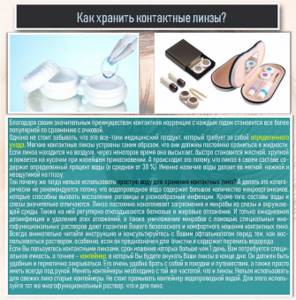
How to use the solution
After wearing, the lenses are placed in a solution. This applies to those models that are designed for multi-day use. When they are removed, they are placed in a container with disinfectant liquid. You can choose any:
- Biotrue;
- ProActive;
- Opti-Free;
- Silver;
- UnicaSensitive;
- Maxima;
- HighFresh.
It is worth carefully reviewing the instructions, because certain types of products are used only for severe contamination once a week. It is better to use multifunctional compounds.
How to wear
How to use for the first time:
- To wash hands.
- Place the lens on the tip of your index finger.
- Look up, pulling the lower eyelid down and the upper eyelid up.
- Carefully place the lens on the lower part of the eyeball.
- Look down, then close your eyes for a couple of seconds.
- Blink your eyes a few times.
The lenses will fit onto the iris themselves. A sign of correct installation is an improvement in visual acuity. For more information on how to put on colored lenses for the first time, please follow the link.
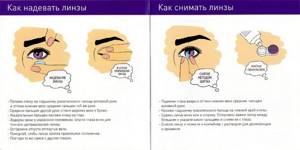
How much to wear
The manufacturer himself specifies the time frame – 4-12 hours. Ophthalmologists point out that the products have lower oxygen permeability, like conventional options, and therefore continuous operation is no more than 6 hours.
How to buy tint and colored contact lenses in the Lens Warehouse online store
First of all, to purchase, you must know exactly the parameters of your vision; they are contained in the prescription prescribed by an ophthalmologist, or they are measured by an optometrist. If you already use contact lenses or you already have a prescription from a doctor, then you can buy contact lenses online at the Lens Warehouse online store.
If you don’t know exactly your parameters, or you haven’t had your eyesight checked for a long time and the lenses you use are uncomfortable for you, you can contact one of our Just Optics salons. It is convenient and profitable: in all our salons, the selection of contact lenses and the issuance of a prescription when purchasing contact lenses are free of charge
.
Buying contact lenses through the Lens Warehouse online store is easy and simple.
The Lens Warehouse online store delivers one-day contact lenses to Yekaterinburg and the cities of the Sverdlovsk region: V. Pyshma, Berezovsky, Koltsovo, Kompressorny, Nizhny Tagil, Kamensk-Uralsky, Pervouralsk, Sysert.
Delivery conditions and how to get free delivery Back to archive
Cost and purchase
Oddly enough, many people to this day believe that high-quality products cost a fortune, but in reality their prices are very affordable. As for colored ones, now there are a huge variety of them available and you can choose them by type and frequency of replacement.
And in these days of online shopping, the prices and availability of contact lenses are really encouraging. For example, high-quality one-day colored lenses can be purchased on the Internet for a price starting from 150 rubles. But for an amount of around 1300-1400 rubles you can purchase a whole monthly set of “one-day items” .
You can buy two-week contact lenses even cheaper. In optical stores, at a price of about 1,400 rubles, customers are offered a set of Acuvue 2 Colors, which consists of 6 blisters, with which you will not have to worry about purchasing new contact lenses for a month and a half.
But a really economical option is contact lenses from FreshLook. FreshLook ColorBlends products must be replaced only after a month; they are sold individually only at a price of about 270 rubles.
If you intend to purchase the highest quality and reliable lenses, you should pay attention to the following manufacturers of these products:
- EOS.
- Lensman.
- Dreamcom.
What parameters are used to determine the size of contact lenses?
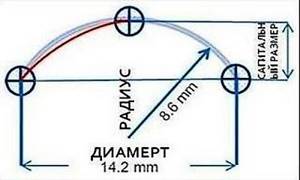
The size of contact optics is determined by two parameters : the radius of curvature and the diameter of the contact lens, which are indicated on the packaging. They are measured using a special device - an autorefractometer.
The first indicator determines wearing comfort, as well as eye health. Essentially, the radius of curvature characterizes the curvature of the outer surface.
And the diameter depends on the size of the cornea and serves as a measure for determining the volume of the sphere, is responsible for the naturalness of the look and ease of use. When selecting optics, the following error occurs. Subjectively , the patient believes that a tighter fit is more comfortable than a looser one. In practice , it is worth finding a middle ground so that complications do not arise.
It is considered that the lens does not fit correctly if itching, burning and redness of the eyes appear. At the same time, factors that cause such symptoms are always excluded: damage, expired expiration date, non-compliance with hygiene rules.
Important! A common cause of such signs is an individual reaction to the material .
In both cases, you need to visit a doctor to find out the cause.
Lens radius of curvature: what is it?
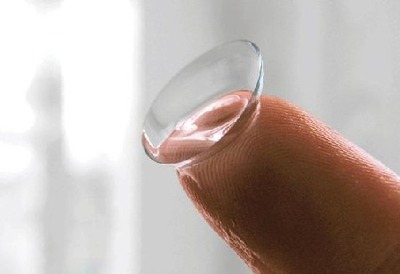
This parameter characterizes the concavity of the inner surface . It comes standard and enlarged. The basic size is considered to be 8.3-8.7 mm. Suitable for most people with normal cornea structure.
The radius of the increased size sometimes exceeds 9.0 mm. The most convex product has a smaller radius. This fact determines the correct landing.
To ensure comfort without visual distortion, the shape of the eyeball (cornea) and the curvature of the lens must follow each other's contours. If the shell has more rounded proportions compared to the cornea (lens circumference is smaller), then the fit will be steep. This leads to excessive tension in the blood vessels and redness of the eyes.
If the membrane has a flatter characteristic (larger lens circumference), the contact optic becomes flexible and the fit is flat. This causes constant friction, which leads to corneal inflammation and swelling. The procedure for determining the radius of curvature itself takes two minutes. It is carried out using computer technology and is painless.
How to find out the size of the cornea
It is the diameter of the cornea or the convex transparent part of the eyeball. In appearance, it resembles a convex-concave lens of an aspherical shape. The vertical size of the cornea is smaller than the horizontal one.
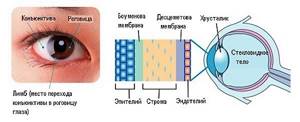
Photo 1. Indicating the location of the cornea and its internal structure, consisting of several layers.
The diameter also varies and ranges from 10.00 to 10.56 mm. In an adult, the horizontal is characterized by a value of 11.8 mm, and the vertical size is 11 mm. In this case, the radius of curvature normally does not exceed 7.8 mm . It also has a certain convexity coefficient.
What does lens diameter affect?
The location of the lens on the eyeball is determined by the diameter of the cornea. The selection of correction means is carried out according to a special table , which has a pattern: the diameter of the cornea is always 1.00-1.50 mm the diameter of the lens This feature provides convenience and comfort. When decentering the sphere, a larger diameter is selected. If there is immobility, it is reduced; if there is excessive displacement, it is increased. This helps relieve tension in the eyes.
Is the curvature of the product greater than the curvature of the cornea?
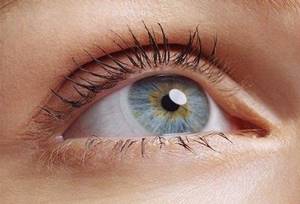
This parameter is considered an individual value for each person. It depends on the features and shape of the cornea.
Since correction devices are placed on the cornea of the eye, they must completely correspond to the natural shape. With standard indicators of corneal curvature, the required radius is considered to be r = 8.6 mm.
Among the products of world brands you can find the best option for every person . In case of non-standard vision parameters, contact the manufacturers personally.
Effect of material on lens fit
In addition to the basic parameters of lens size, the quality of fit is also influenced by the material from which the contact optics are made.
Important! The correct fit can only be determined by a doctor . As a result of self-selection, there are frequent cases of hypoxia, which leads to infectious diseases and keratitis.
Each formulation, hydrogel or silicone hydrogel , has a different fit with the same curvature. Hydrogel lenses are infused with a low-moisture gel. With the loss of the aqueous component, the dimensions of the contact optics themselves change, and the fit on the cornea becomes more dense.
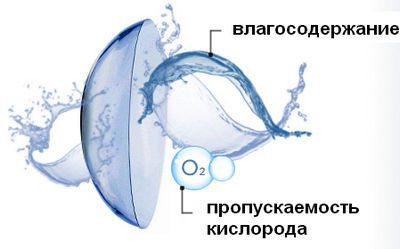
For convenience, biocompatible technologies , the main advantage of which is components similar in composition to the natural tear film . They prevent excess evaporation.
Silicone hydrogels have a breathable texture . The material contains siloxane, which has higher breathability coefficients. Despite the better fit compared to hydrogel ones, they require additional moisture to ensure the greatest comfort.
To determine the correct fit, a test is performed. To do this, the lens is moved up the cornea. If it freely returns to the central position, it means it fits the curvature parameters. Normal mobility is 1.5 mm. This is necessary to provide the eye with natural tears.
